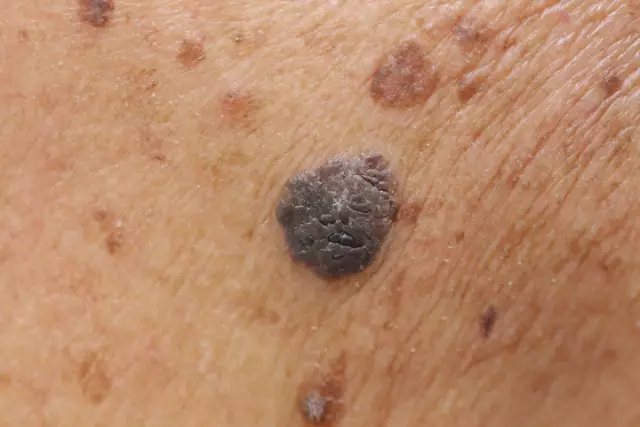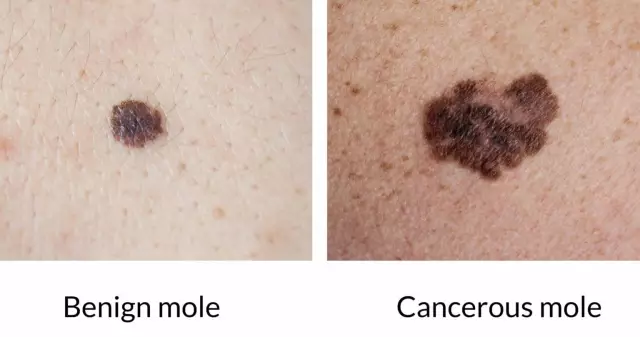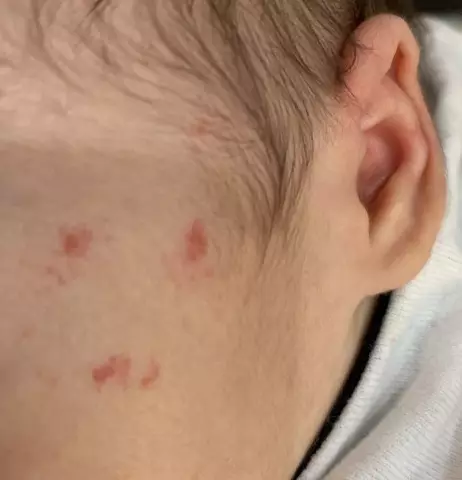- Author Rachel Wainwright [email protected].
- Public 2023-12-15 07:39.
- Last modified 2025-11-02 20:14.
Red mole

Moles of different colors, sizes and shapes can appear on different parts of the human body. Sometimes they get to a person from birth, and often form over time. A mole is usually a benign tumor and does not cause any discomfort. It can pose a danger in some cases, when from a benign one is reborn into a malignant one. A red mole is formed due to dysfunction of the capillaries and consists of a large number of microscopic vessels. It can appear on almost any part of the body, so treatment directly depends on its location.
Red mole, features
The medical name for a red mole is angioma. This type of moles belongs to the category of safe skin diseases. The main feature of an angioma is a change in its color when it is pressed on: the mole turns pale on palpation, then acquires its original shade.
There are several types of angiomas:
- Stellate or arachnid;
- Point;
- Cavernous or cave.
Usually a red mole is a flat growth that rises slightly above the surface of the skin and consists of small blood vessels. Small capillaries, which are visible to the naked eye, extend from it in different directions. Such moles are called stellate or arachnid.
A punctate angioma is a mole that is unobtrusive and looks like a small red dot. A cavernous angioma is called several consecutive moles located close to each other.
As a rule, red moles do not pose a danger to human health and appear on the body almost imperceptibly. They do not cause pain, with rare exceptions that require immediate examination and specialist advice.
An angioma of an especially large size in medicine is called hemangiomatosis. A similar pathology is characterized by excessive growth of capillaries and is treated, as a rule, by surgical intervention.
Red moles, reasons
The exact causes of red moles have not yet been established by specialists. There are only a few assumptions that most doctors agree on. Let's consider the most common versions:
- Hormonal changes and disorders;
- Excessive work of blood vessels and capillaries;
- Dysfunction of pigment cells;
- Various diseases of the gastrointestinal tract.
It is believed that in an adult, the most common cause of red moles is various hormonal disorders. However, moles of this color are most often found in children and adolescents. Experts explain this fact by certain changes in the human circulatory system and its overly intense work, which is typical for this age.
Pigment cells are responsible for the pigmentation of human skin, so any abnormality in their functioning can also cause red moles.
Many doctors consider the occurrence of a red mole as one of the symptoms of diseases of the gastrointestinal tract. We are talking, in particular, about diseases of the pancreas and liver. True, the appearance of such moles does not always indicate the presence of such problems. However, for your own peace of mind, it is still advisable to be examined by a doctor.
Some experts associate a red mole with a lack of ascorbic acid in the body. Microtrauma of the skin, arising, for example, after shaving, in this case, can lead to damage to the vascular walls. This is another reason for red or pink moles.
Treatment of red moles
In most cases, red moles do not require treatment and go away on their own. In addition, if the angioma does not increase in size, does not cause discomfort and painful sensations to the person, it can be considered harmless. In such situations, experts do not recommend removing the red mole. The situation is different when it forms on the face and spoils the appearance of a person. In addition, if the angioma increases in size and changes its color, you should immediately seek medical advice.
To date, the removal of a red mole is carried out using the following main methods:
- Moxibustion;
- Surgical intervention;
- Electrocoagulation;
- Laser surgery;
- Radiosurgery.
Removing a red mole with moxibustion is usually not effective. This is due to the fact that it is most often located in the deep layers of the skin, that is, only the upper part of it is visible on the surface. Often, after the moxibustion procedure, the roots of the red mole remain inside the skin, which contributes to its reappearance in the same area.
Together with this, today there is a fairly effective method of eliminating angioma by freezing it. The procedure takes a few minutes. The tissue of the mole is affected by liquid nitrogen, after which it disappears on its own within a month.
The method of surgical intervention for the treatment of red moles is gradually losing its relevance, since it has a number of disadvantages. The most important of these is the scars that remain after surgery. Therefore, the surgical method is not recommended for people who have angiomas on the face. In addition, it is painful compared to other modern methods.

The method of electrocoagulation is also often used today to treat red moles. It consists in acting on them by means of a high frequency current. With this procedure, the electrode burns the angioma, leaving a thin crust in its place, which also disappears after a week. Experts say that the main advantage of this method is the ability to analyze a mole for the presence of malignant cells.
Laser surgery is considered perhaps the most common way to treat angiomas as it is the least painful and leaves no scars or marks.
The method of radiosurgery is one of the newest methods of treating red moles, which may soon become a serious competitor to laser plastic surgery in this matter. The device that is used during the procedure performs 3 important functions at once:
- Removes a mole;
- Stops blood;
- Prevents wound infection.
This method also leaves no traces.
YouTube video related to the article:
The information is generalized and provided for informational purposes only. At the first sign of illness, see your doctor. Self-medication is hazardous to health!






